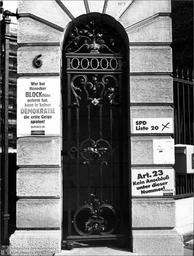S08E09 PT01 Why Run Lola Run?
Duration: 00:12:03; Aspect Ratio: 1.778:1; Hue: 45.960; Saturation: 0.040; Lightness: 0.217; Volume: 0.123; Cuts per Minute: 20.576; Words per Minute: 0.913

[Yes: the annotations are still incomplete. But: did you know that you can just make an account on Pad.ma and help us fix it?]
[You should set "Subtitles" to "English" and open the "Places" bin above. You may also want to switch "Show Annotations" to "At Current Position"]
Why
Run Lola Run? Because it's the worst German film of the 1990s.
The guy who made Run Lola Run
should have taken a look at [Ulrike Ottinger's Bildnis einer Trinkerin / Aller jamais retour
] and given up. -
Pirate Cinema Berlin, S05E05
^ DIE BOOTLOUNGE IN DER ZIEGELSTRASSE:
NACH 10 JAHREN IMMER NOCH NICHT FERTIG
Ziegelstraße

Grundprobleme der 90er in Deutschland: Anschlußfehler und Halluzinationen von "geographic license"

unknown location

EXAMPLE

unknown location

unknown location

Linienstraße

Scheiß Jogger immer: Touristin macht Berlinerin platt

Bitch!

Shit slut!

unknown location

Dies sind die schlechtesten Teile des Films
Typisch Berlin in den 90ern: Sechser im Lotto

Und wo will Lola eigentlich hin? Na sowas: Zu Pirate Cinema in die Ziegelstraße! Von der Linienstraße aus war das eine ziemlich dämliche Route. Siehe auch:


Jackpot: Product Placement Bild-Zeitung


Skalitzer Straße

Oberbaumbrücke

Friedrichstraße

Mauerstraße

Typisch Berlin in den 90ern: Nonnenkolonne in Mitte

Typisch Berlin in den 90ern: Fahrraddealer an der Friedrichstraße

Uncooles Outfit, uncooles Product Placement

90er Sozialdarwinismus vom Feinsten

U1

Zahlste nicht, wird dein Produkt in den Flash-Forward abgeschoben und unten angeschnitten

WMF

Osnabrücker Straße

Director cameo?

Sehr schlechter Autounfall

Lame!

Ziegelstraße

Scheiß Jogger immer: Touristin macht Berliner platt.
Diesmal war's immerhin nicht mir Absicht. Und to be fair, Monbijou Ecke Ziegel war schon immer berüchtigt als gerfährlicher Ort für Rechtsabbieger ohne Ortskunde.

unknown location

ARGUMENT

To someone who knows Los Angeles only from movies, it might appear that everyone who has a job lives in the hills or at the beach.

TO LIVE AND DIE IN L.A. (1985)

The dismal flatland between is the province exclusively of the lumpen proletariat. And most of them live next to an oil refinery.

DEAD HOMIEZ (1997)

TO LIVE AND DIE IN L.A. (1985)

CITY OF INDUSTRY (1997)

And in death they will rest next to an oil derrick.

THE LEARNING CURVE (2001)

A hillside house may be appropriate for a hack composer.

NOCTURNE (1946)

Or a drug dealer on the way up.

DEEP COVER (1992)
 Nouveau anal
Nouveau anal I think this is called.

Or a music promoter on the way down.

THE LIMEY (1999)

But in reality, a bookstore clerk couldn’t afford to rent a house above Sunset Plaza, even if it is, as she claims, "small and kind of run-down." A fixer with jetliner views, in the local realtor jargon, would still have rented for two or three thousand dollars per month in 1995, no matter how much in need of TLC.

HEAT (1995)

Her bank robber boyfriend might live in Malibu.

And back in the sixties, bohemian young people did live by the sand in Venice, although I don’t remember the Infinite Pad.

MARLOWE (1969)

We may regard Cobra's Venice loft as a relic of the golden eighties when product placement superseded script-writing and movie cops abandoned the suburbs to become urban pioneers.

COBRA (1986)

But what about a struggling true-crime writer and an unemployed photographer so cash-strapped they must recruit paying passengers for their move from Pittsburgh to California?

KALIFORNIA (1993)

Yet when they arrive in Los Angeles, they immediately take up residence in a spacious Malibu beach cottage.

And I don’t like geographic license. It’s hard to make a theoretical argument against it. After all, in a fiction film, a real space becomes fictional. Why shouldn’t a car chase jump from the Venice canals to the Los Angeles harbor thirty miles away?

Why shouldn’t the exit from a skating rink in Westwood open directly onto Fletcher Bowron Square in downtown Los Angeles, fifteen miles east?
But one fiction is not always as good as another.
 And like dramatic license, geographic license is usually an alibi for laziness. Silly geography makes for silly movies.
And like dramatic license, geographic license is usually an alibi for laziness. Silly geography makes for silly movies.

COUNTEREXAMPLE

Why
Possession? Because it's the best film made in Berlin in the 1980s.
Easily the most memorable two hours of cinema ever shot in Kreuzberg, Andrzej Zulawski's Possession
[...] provides for a series of highly iconic scenes of picture-perfect West-Berlin desolation that make for an exceptionally authentic and period-accurate Heimatfilm. -
Pirate Cinema Berlin, S04E07
Lohmühlenbrücke
Possession (Andrzej Zulawski)

Funktional wie ästhetisch gelungene Architektur: die Westseite der Mauer

SPOILER: THE DOG DIES
SPOILER: THE DOG DIES


rapport animal a l'animal 🤠🐕

Gustav-Freytag-Straße

Sehr guter Autounfall

Schlesische Straße

Sehr gute Musik


^ IST DAS NOCH ZALANDO ODER SCHON ZOOM?
DAS MUSS ALLES WIEDER ABGERISSEN WERDEN!

Cuvrystraße
Pad.ma requires JavaScript.